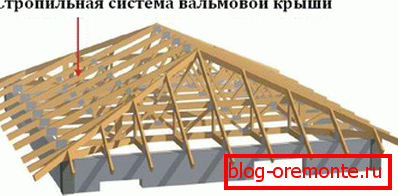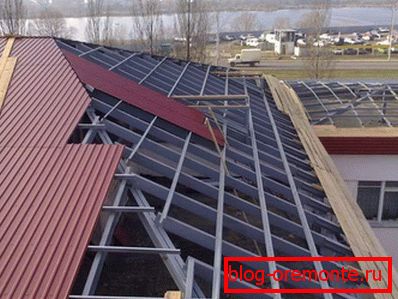Hinged roof ramming - device and drawings
Hip roof is probably the most popular type of hipped roof. It is suitable for overlapping private houses of large and small areas, baths, even gazebos. Recognizable geometry gives it a truss system of the hip roof, a set of supporting elements, working as a frame.
The complexity of this design lies in the large number of component parts and attachment points that require special skills and experience. This article will answer questions about what it consists of, what materials are used for construction, as well as how to perform installation work.


Hip roof construction
The hip roof is of the hip type, that is, it is formed from four slopes, planes having one common side. Two slopes, replacing the gables, called hip or end, they have a triangular shape. And the other two, in the form of a trapezoid, denote the term facade. The line in which all four slopes meet is the ridge, the highest part of the roof. The hip-type construction consists of:

- Hip slopes, which have the shape of a triangle, located on the site belonging to the gables.
- Front slopes trapezoidal shape.
- The ridge, the line that forms the upper junction of trusses, the tops of the hip roof.
- Overhang protruding beyond the perimeter of the house part of the roof, formed by the length of the rafter legs or fillies. It protects the surface of the walls from melt and rainwater.
- The truss system of the hip roof, the frame supporting and distributing the weight of the roof structure.
- A roofing material, a coating that is laid on the rafter legs of the hip roof to protect it from precipitation.
- Drainage, drainage system, accumulating on the roof. It consists of a gutter, a water intake funnel and a downpipe and transfers moisture from the surface of the blood to the storm sewer.
- Snegozaderzhateli, elements that do not give the snow masses that have accumulated on the roof, collapse and injure people passing by.
Types of truss system
The roof system of the hip roof can be of three types, depending on how the rafters are arranged:
- Hanging. This means that the rafters are supported on two points: in the upper part on the ridge girder, and in the lower part on the mauerlat. Hanging truss system is experiencing stress deflection, compression and expansion. All these forces have a destabilizing effect on it, therefore additional compensating elements are necessary - tightening, crossbars, headstocks. They complicate the design and installation of a hip roof, so experienced roofers are advised to abandon hanging rafters, if possible.
- Outlaw. With this type of truss system of the hip roof, the rafters are supported by three points: at the top of the ridge, in the middle at the rack, and at the bottom at the power plate. Racks are installed on the internal bearing walls. Additional vertical supports reduce the deflection of rafter legs and eliminate gripping forces. Therefore, the nasal system is considered more reliable and more stable than the trailing one, and moreover, it is simpler to install.
- Combined. This term means that the roof system consists of alternating nylon and trailing elements. This is possible if a pole or column is used as a support for the rack, rather than an internal load-bearing partition. The roof is of an open type, that is, all the beams and pillars are not hidden by the covering, but are visible.

Important! With the help of a hanging truss system, it is possible to block the structure no more than 6 meters wide. The use of napsal rafters with one additional support increases this distance up to 12 m, with two - up to 18 m.
Material used
Hip-type roof system consists of a set of components that reflect the drawing, they are made of the following materials:
- Made of metal. In this case, use the corners and I-beams made of galvanized metal. It is a durable, corrosion-resistant, durable material that can withstand heavy loads. Do metal rafters have two significant disadvantages - considerable weight and high cost. Therefore, the use of metal in the construction of the roof is extremely rare, especially in private housing.

- Out of wood. The most commonly used tree is hardwood, for example, pine. The advantages are obvious - light weight, low price, ease of processing. The weak point of a wooden truss system is susceptibility to rotting, the action of microorganisms and pests. However, this problem is solved by treatment with antiseptic compounds. By the way, those who care about fire safety use flame retardants.

Properly processed and prepared wood is an excellent material for making a truss system. It is much easier to work with him, he does not require a special tool. A pleasant price will reduce costs. Moreover, the metal frame of the roof can only afford those who are confident in the safety margin of the foundation.
System elements
Depending on the area and features of the layout of the house, the truss system of the hip roof takes on different forms, but it is based on the following elements:

- Mauerlat, representing a timber section of 100x100 mm or 150x150 mm. Its task is to evenly distribute the weight of the roof structure around the perimeter of the load-bearing walls. The lower parts of the rafter legs are attached to the mauerlat.
- A bed made of a bar with a thickness of 100 mm or more, which performs the functions of a mauerlat on the internal bearing partitions. On the ground mount rack.
- Ridge girder, wooden bar, which is supported by the upper parts of the truss legs. It connects a vertical rack.
- Diagonal rafters, forming ribs hip slopes. They are fastened in such a way that they continue the ridge and diverge to the corners of the house. There are four diagonal truss legs in the hip roof, they are attached to the ridge girder and the mauerlat. These rafter legs are long and subjected to heavy loads, so their thickness should be twice as large as the rank and file.

- Ordinary rafters, which serve as a support trapezoidal rays. For the manufacture of used boards of size 50x150 mm or 100x150 mm. The upper part of ordinary truss legs rests on the ridge girder, and the lower part on the mauerlat. The step between them is taken 60-120 cm, the size of the applied heater and the weight of the roofing material affect its size.
- Narozhniki, shortened rafters, attached by one side to the diagonal, and the other to the mauerlat. The distance between ladies should not exceed 70-80 cm, and the dimensions of the lumber do not have much importance, since the load on them is not great.
- Racks, that is, vertically arranged supports of timber. Racks are installed on a log, they support the rafter foot in the middle part or ridge girder, depending on the nature of the use of the attic.
- Tightening, horizontal jumpers between the legs of each truss pair. Tightening rafters, removing the bursting load on the wall. The bolt located high on the ridge is called the bolt, and the low-lying one is used as a floor beam.
- Podkosov, subrafter legs, which are located at an angle to the rafters to reduce their deflection under its own weight.
- Sprengel, vertical supports diagonal rafters. Designs with vertical posts and horizontal contractions are called trussed trusses.
Note! Some elements of the truss system of the hip roof are of considerable length. And the standard size of lumber from wood is limited to six meters. To get out of this problematic situation, roofers make glued or rammers, composed of two or three parts.
Mount Maurlat
Mount Maurlat – отправная точка создания стропильной системы для вальмовой кровли. Правильная установка обеспечит надежное основание для стропил. Во время строительства дома из бруса или бревна роль мауэрлата выполняют верхние венцы. В сооружениях из кирпича, газосиликатных блоков его крепят следующим образом:

- On the upper section of the walls, formwork is made and a concrete reinforced belt is poured into which metal studs are embedded.
- Mauerlat bar treated with antiseptic deep penetration and make holes in it for studs. Moreover, the location of the holes is calculated in such a way that they do not coincide with the attachment points of the rafter legs, but lie between them.
- After solidification of the concrete belt, which occurs within 2-3 days, waterproofing is mounted on it. These functions are usually performed by folded soybean in two soybeans.
- Mauerlat laid on the waterproofing and attract with metal pins.
Please note that a large number of holes reduce the strength of the power plate, provoke the appearance of cracks, defects, reducing its support functions. Remember, in the mauerlate they never perform cuttings under rafters, it is impossible to violate its integrity!
Assembly stages
The result of the calculation, made manually or by program, is fixed by creating a drawing which reflects the dimensions and relative position of the truss system, and then begins to assemble it according to the following plan:
- Install the power plate and the bed as described in the previous paragraph. The racks are mounted on the floor in order not to preserve their vertical position, temporary struts are used, the corners are checked at the building level. A ridge girder is attached to the stands using metal corners or nails.
- If this requires the project put the struts from the timber. The top of the nails nailed at the middle of the rafters, and the bottom to the drains.
- Install diagonal rafters. Carry out a double inset at an angle of 45 degrees, attaching them to the ridge with nails. The lower part of the leg is attached to the mauerlat by a movable joint of the slider type.

- Strengthen diagonal rafters trussed trusses. The adjacent sides of the Mauerlata are engaged in a scrum, pushing the lower part of the Sprengel into it. The upper part is substituted for the diagonal rafters.
- Mounted ordinary stop. First, install the front and rear pair of legs, between them pull the cable and, aligning it, put the rest.

- Installs Planners. Take one board, try on, mark on it drank under the power plate and diagonal rafters. Half of the choppeaters are made according to this pattern, and the rest are mirrored. Attach with nails or corners. The ends of the rafters are left uncut.
- Between the diagonal rafters they stretch the thread and trim the rafters so that their length forms an overhang of 40-50 cm. The wind board is mounted.

- Lay the crate. The sheathing scheme is selected according to the recommendations for a specific type of roofing material. For a soft, rolled roof make a continuous OSB sheet, and for metal tiles and corrugated flooring lattice crate is suitable.
Competent calculation, detailed drawing and high-quality installation is the key to long service life and reliability of the roof truss system.